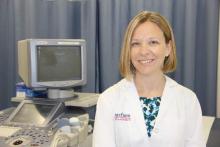A national group that includes ob.gyns., nurse-midwives, anesthesiologists, and other providers has released a safety bundle with 13 steps that hospitals can use to prevent, recognize, and better manage obstetric hemorrhage.
The new safety bundle draws on evidence from several existing evidence-based guidelines and the work of safety collaboratives in California and New York. The idea behind the bundle’s release is to standardize the response to obstetric hemorrhage across hospitals, whether they deliver hundreds of babies a year or thousands. Not every hospital will have the same approach, but they should all have a standardized response that is triggered by excessive bleeding during delivery.
“Our goal with this bundle is to make any hospital in the country that does obstetric care understand the basic elements that they should have considered and thought through and dealt with, with their own multidisciplinary team,” said Dr. Dena Goffman, director of maternal safety and simulation at Montefiore Medical Center in New York City.
The hemorrhage bundle is the first national maternity patient safety bundle released by a multidisciplinary workgroup of the National Partnership for Maternal Safety, part of the Council on Patient Safety in Women’s Health Care. Future safety bundles will focus on severe hypertension and venous thromboembolism.
These efforts come as the United States ranks worst among developed nations, and 60th overall, in maternal mortality, according to the Health Resources and Services Administration. Obstetric hemorrhage is a good first target, the workgroup members said, because it is both the most common serious complication of childbirth and the most preventable cause of maternal mortality.
The hemorrhage safety bundle calls on hospitals to implement 13 steps focused on readiness, recognition and prevention, response, and reporting and systems learning.
Readiness
1. Create a hemorrhage cart with medication and other supplies that might be needed immediately.
2. Create a kit (or equivalent) for immediate access to hemorrhage medications that may need refrigeration.
3. Establish a response team.
4. Establish protocols for massive transfusion and emergency release of blood products.
5. Perform unit education on protocols, including regular unit-based drills.
Recognition and Prevention
6. Assess hemorrhage risk at various times, including antepartum, on admission to labor and delivery, later in labor, and on transfer to postpartum care.
7. Measure cumulative blood loss.
8. Actively manage the third stage of labor.
Response
9. Create a stage-based obstetric hemorrhage emergency management plan similar to a “Code Blue” for cardiopulmonary arrest.
10. Provide a support program for patients, families, and staff for all significant hemorrhages.
Reporting and Systems Learning
11. Establish a culture of brief planning meetings, huddles for high-risk patients, and postevent debriefings.
12. Perform formal, multidisciplinary reviews of serious hemorrhages to identify systems issues.
13. Monitor outcomes and process metrics such as the number of women who receive four or more units of red blood cells or who require care in the intensive care unit.
The overall goal of the safety bundle is to eliminate the “denial and delay” that are commonly seen in obstetric emergencies, said Dr. Elliott K. Main, medical director of the California Maternal Quality Care Collaborative.
“It’s partly because we are spoiled in obstetrics by having essentially young, healthy women who can withstand a lot of bleeding, for example, and not have anything go wrong,” he said. “If you’re young and healthy, you do look good until suddenly you don’t.”
One of the main elements of the safety bundle is creating a hemorrhage cart – stocked with necessary supplies and medications – that is immediately available in the birthing unit, with similar materials available on the antepartum and postpartum floors. The safety bundle does not specify what should go in the cart, only that the materials should be determined with input from obstetric, anesthesiology, nursing, midwifery, and pharmacy providers.
It’s that communication among a multidisciplinary team of providers that is really the centerpiece of the safety bundle, according to physicians who worked on the document, which was published simultaneously in the Journal of Obstetric, Gynecologic, & Neonatal Nursing; the Journal of Midwifery & Women’s Health; Anesthesia & Analgesia; and Obstetrics & Gynecology (Obstet. Gynecol. 2015;126:155-62).
Along with the hemorrhage cart, the bundle calls on hospitals to establish a response team and protocols for the emergency release of blood products for massive transfusion.
The members of the team would vary depending on the severity of the hemorrhage and the resources at the hospital. But the team could include the primary obstetrician and nurse, as well as representatives from anesthesiology, the blood bank, the pharmacy, advanced gynecologic surgery, critical care medicine, and interventional radiology. Social services support, such as chaplains, should also be available as needed, according to the document.


